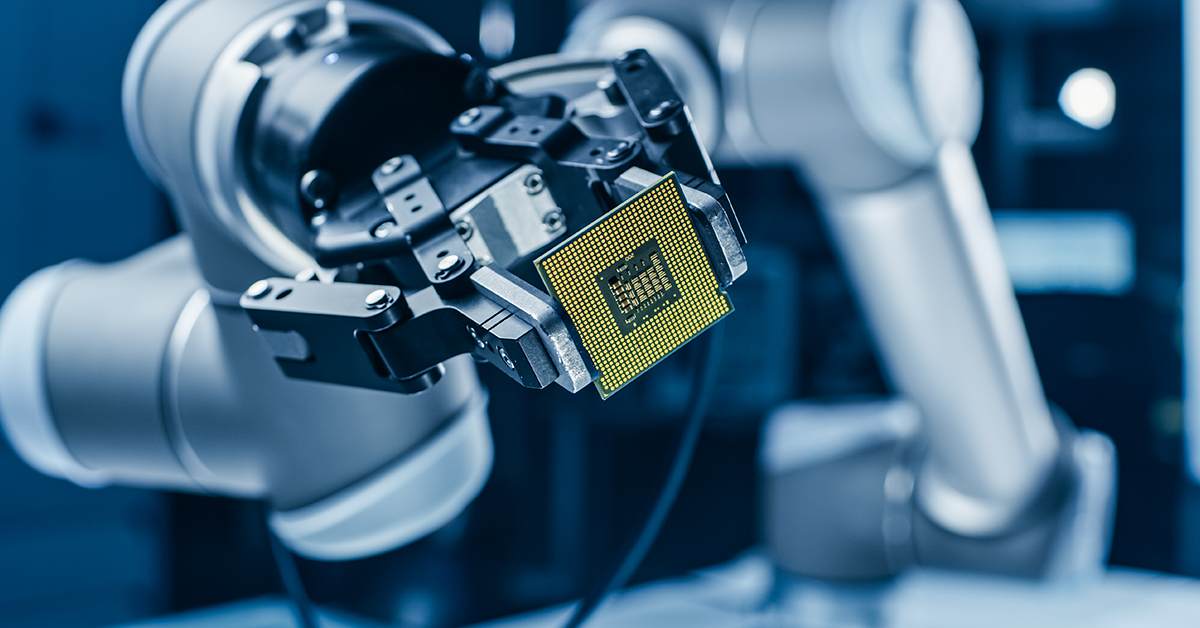The chip market in the United States remains a vital segment for the federal government. Present and emerging technologies depend on semiconductors, including the weapons and systems needed to succeed in the most critical missions.
The CHIPS Act of 2022 propels the US chip market to remain competitive. Let’s explore the CHIPS Act and its impact on the chip market and the government contracting industry.
Table of Contents
The CHIPS Act: History and Background

The Creating Helpful Incentives to Produce Semiconductors (CHIPS) and Science Act was signed into law by President Joe Biden in August 2022. It provided funding to support the domestic production of semiconductors in the United States, as well as catalyze investments and innovation for the US competitiveness in the global chip market.
How was the CHIPS Act formed?
The CHIPS Act is a combination of two bipartisan bills, namely the Endless Frontier Act and the CHIPS for America Act.
The Endless Frontier Act, introduced by Senators Chuck Schumer and Todd Young in 2019, was initiated to support investment in high-tech research for the US’s national security. The act aims to grow government research and development (R&D) investments from $150 billion to $500 billion, gain match investments from the private sector, and forge a technological alliance called the Techno-Democracies 10.
On the other hand, the CHIPS for America Act was formed partly due to the Under Secretary of State Keith J. Krach’s brokering for the on-shoring of the Taiwan Semiconductor Manufacturing Company (TSMC). Krach’s goal was to:
- Secure the supply chain of sophisticated semiconductors
- Attract TSMC’s ecosystem of suppliers
- Influence other chip companies to manufacture semiconductors locally
- Inspire universities to develop engineering curricula on manufacturing semiconductors
- Design a bipartisan bill on funding for semiconductor production
On July 28, 2020, the Endless Frontier Act and the CHIPS for America Act were merged into the present CHIPS and Science Act. Consolidating the two bills amended their differences and established a robust semiconductor manufacturing industry that benefits the US and its allies.
Related article: Senate Passes Bipartisan Bill to Streamline Federal Reviews for Semiconductor Projects
CHIPS Act: How does it influence the chip market and the government contracting industry?

President Biden signed the CHIPS Act into law on August 9, 2022, authorizing nearly $280 billion in funding. Nearly $53 billion dollars of this budget was intended for semiconductor manufacturing, workforce development, and research and development (R&D).
Under the CHIPS and Sciences Act, relevant government contracting industries also receive funding and support. The primary industries that benefit from the CHIPS Act include:
Telecommunications – The CHIPS and Science Act finances 5G deployment, which entails bolstering 5G supply chains.
Automotive – Through the CHIPS Act, the automotive sector receives government backing to propel the electrification of autonomous vehicles using semiconductors.
Defense – The CHIPS Act capacitates funding for the production and R&D of specialized chips that meet the needs of defense and national security agencies.
Technology – The bipartisan law paves the way for new technologies powered by semiconductors to be developed and introduced into the private and public sectors.
While the bipartisan law was signed in the third quarter of 2022, investments coming from the government’s coffers only started trickling out by the third and fourth quarters of 2023. The White House has granted portions of the total budget to government contracting companies and federal agencies that utilize semiconductors in their services and products.
Government Contracts and Provisions Granted Under the CHIPS Act
Outlined below are some of the provisions and government contracts awarded under the CHIPS and Sciences Act.
BAE Systems’ Production of Semiconductors for Military Aircraft
BAE Systems was one of the first government contractors to receive funding under the CHIPS Act. With provisions worth $35 million, BAE Systems has the capacity to increase the production of specialized chips for military aircraft in its New Hampshire semiconductor plant.
Intel’s Contract for Building State-of-the-Art Chips for the US Armed Forces
On March 7, 2024, Intel Corporation secured a contract for manufacturing advanced semiconductors for the military and intelligence programs. Intel received funding worth $3.5 billion, which will be dispersed in the next three years.
This CHIPS Act provision tasked Intel to support the construction of “secure enclaves,” a top-secret line of high-end semiconductors for the US Armed Forces. This contract award cemented Intel as the prime producer of silicon for the defense market.
The National Science Foundation’s Regional Innovation Engines Program
In May 2023, the National Science Foundation (NSF) launched the Directorate for Technology, Innovation, and Partnerships. It introduced the Regional Innovation Engines program, an effort authorized by the CHIPS and Sciences Act to harness the US’s R&D and science and technology resources to catalyze robust partnerships.
NSF’s Regional Innovation Engines program had a contract value of $44 million, spread across 44 institutions comprising universities, non-profits, and private businesses. Each organization was awarded $1 million to fulfill the program’s requirements in two years.
The Department of Commerce’s Provision for Manufacturing Incentives
Six months after the CHIPS Act was signed into law, the US Department of Commerce (DoC) launched the first funding opportunity worth $39 billion for the provision of manufacturing incentives. With this funding, the DoC was given the capacity to finance the construction, modernization, and expansion of chip market facilities that produce semiconductors.
The Department of Commerce’s Tech Hubs Program
In May 2023, the DoC released the first funding of Phase 1 of the $500 million Tech Hubs Program. The program strengthened the economy and national security by supporting the commercialization, deployment, and regional manufacturing of innovative and advanced technologies.
The Department of Commerce’s RECOMPETE Pilot Program
In June 2023, the DoC was provided $1 billion in funding to support its RECOMPETE pilot program, which took place at the department’s Economic Development Administration (EDA). Through this program, the DoC was able to create more jobs and propel regional economic growth in the most distressed communities.
The RECOMPETE pilot program poised these communities as leaders in high-growth sectors, namely the AI, advanced manufacturing, and clean energy nanotechnology industries.
The Department of Commerce’s Innovation Fund
On April 12, 2023, the Department of Commerce’s National Telecommunications and Information Administration (NTIA) announced the first investment scheme for the Innovation Fund. Valued at $1.5 billion, this CHIPS Act grant program was designed to advance open wireless technology networks over the next 10 years. It includes provisions for the following:
- Promoting secure, open, and virtualized 5G+ technologies
- Supporting the assimilation of networks with diverse equipment brands
- Deploying open and interoperable equipment
- Utilizing criteria to assess whether equipment acquiesces to open standards
Related article: Intel’s Dominance in the Chip Market: A Comprehensive Analysis
What does the federal government want to accomplish with the CHIPS Act?

The CHIPS Act was primarily formed to provide funding for the production of semiconductors In the United States. With nearly $53 billion dollar in appropriation for manufacturing and R&D procedures, the federal government aims to accomplish the following:
Increase American International Economic Competitiveness
Decades ago, the US held the top spot for global semiconductor production, accounting for 40% of the world’s supply. Increased demand for semiconductors paved the way for other countries to gain a foothold in the chip market. As a result, the US’s hold on the chip market dwindled, producing only 10% of the global chip market.
To regain the US’s lead position, policymakers introduced the CHIPS Act to be on par with other dominant chip producers, such as Taiwan and South Korea.
Restoring the US as a global leader in semiconductor production entails a boost in the nation’s international economic competitiveness. With the CHIPS Act’s funding, the US can produce advanced semiconductors that can power next-generation AI computers and mobile devices.
Create More Employment Opportunities
Increasing the US’s economic competitiveness ushers in the creation of more high-paying jobs in the semiconductor industry. According to a paper by Carnegie Endowment, the decline of the US’s share in the chip market led to a decrease in manufacturing jobs over the past 30 years.
Policymakers project that the flow of cash through the CHIPS Act can bring in employment opportunities for the creation and delivery of semiconductors locally and internationally. The new jobs are projected to replace the low-skilled manufacturing lost over time due to labor-saving technologies.
The addition of jobs establishes a symbiotic relationship that bolsters the US chip market. A part of the CHIPS Act’s funding is to also provide competitive wages for laborersto encourage the workforce. In return, it burgeons manufacturing plants to sustain the present and future of America’s semiconductor industry.
Protect Semiconductors From Being Sabotaged During the Manufacturing Process
As a critical part of defense, intelligence, and military technologies, semiconductors are at risk for sabotage. Policymakers authored the CHIPS and Sciences Act to help mitigate the risks associated with manufacturing processes by creating iron-clad semiconductor security and improving them regularly.
The CHIPS Act also entails the building of facilities with reduced bulk-institutionalized sabotage features. Chips manufactured locally are less likely to be affected by outside sabotage.
However, sabotage caused by an inside job still poses a threat to chip market facilities. That said, the federal government and private companies are working together to develop transparency, accountability, and trust-building measures to bolster the anti-sabotage features.
Reduce Semiconductor Shortage
The call for US policymakers to construct the CHIPS and Sciences Act was largely due to the increased demand for semiconductors at the height of the pandemic.
As demand for semiconductors soared, so did the prices to procure materials and develop them. The inflationary pressures escalated the geopolitical tensions between the US and China, given that both are dependent on Taiwan for semiconductor manufacturing.
Potential attacks on Taiwan can devastate the US’s source for semiconductors, negatively impacting the technology sector.
The CHIPS Act aims to diversify the locations of chip-making facilities all over the United States to mitigate semiconductor shortages caused by conflict or economic crashes in East Asia.
Stave off Geopolitical Tensions
Geopolitical shocks can also cause semiconductor shortages. Carnegie Endowment highlighted that if the world becomes dependent on chips manufactured in China, the Chinese government can weaponize that dependence for its interests.
In addition, China can sabotage the global shipments of semiconductors to gain confidential information and warfare intelligence, as well as disrupt critical government operations.
The CHIPS Act staves off geopolitical tensions as it reduces the US government’s need to procure semiconductors from international manufacturers. It enables the US to prevent conflict with China and other adversaries.
Related article: CIA’s Jennifer Ewbank On Why China Is the ‘Most Pervasive’ Cyber Threat to US Today
Frequently Asked Questions
Who is the largest chip manufacturer in the world?
The Taiwan Semiconductor Manufacturing Company (TSMC) is currently the largest semiconductor manufacturer in the world. In 2023, TSMC earned a revenue of $69.3 billion, surpassing Intel’s $54.3 billion and Samsung’s $50.99 billion.
What is the #1 semiconductor company in the US?
According to a March 2024 report by Statista, NVIDIA emerged as the top 1 semiconductor manufacturer in the United States in terms of market capitalization, having made $2.2 trillion. Broadcom ranks second, followed by AMD, Intel, and Qualcomm.
Which companies will benefit from the CHIPS Act?
Among the CHIPS Act’s goals is to strengthen the semiconductor manufacturing divisions of private companies. The companies that can benefit from this law are:
- Intel is expected to receive funding worth $19.7 billion for constructing semiconductor production facilities in Ohio.
- Micron Technology will receive $10.3 billion, with $100 million to be appropriated for building the largest fabrication facility in Central New York.
- GlobalFoundries will be granted $1.5 billion in recognition for its extensive manufacturing and semiconductor research footprints.
- Texas Instruments is projected to receive $2.1 billion to upgrade its R&D facilities and efforts.
- Other smaller chip-making companies, such as Macom Technology Solutions, SkyWater Technology, and Wolfspeed, are expected to receive funding from the CHIPS and Sciences Act.
You might also want to read: How Small Businesses Can Secure a Portion of $53B CHIPS Act Funding



